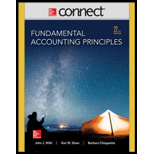
Concept explainers
Perpetual Inventory system is an inventory system in which a organization continuously update its inventory records. All the movements related to inventory are updated continuously such as purchase quantity, sales quantity, and purchase or sales return etc.
There are several methods of calculating the value of inventory in closing stock which are as below:
FIFO method (First In First Out) is the most using method of
LIFO method (Last In First Out) is the method in which the quantity which purchase in last before sale transaction will be sold first. In closing inventory the quantity will be counted from the beginning inventory and purchase thereafter.
Weighted Average method is the most commonly used method after FIFO method. In weighted average the quantity of all purchases and beginning inventory is clubbed and then a weighted average rate is calculated and closing inventory is valued at weighted average rate.
Specific Identification method is the method in which the quantity is specifically identified that from which lot or purchases the closing stock is available and the closing inventory is valued by taking rates and quantities of that specific lot(s) from which closing inventory is available.
Under perpetual method a job card is prepared for each lot and calculation is done for each lot/transactions accordingly.
Requirement-1:
To Calculate:
In the given question we have to calculate the following details under perpetual inventory system:
- Cost of goods and quantity available for sale
Requirement-2
To Calculate:
We have to calculate units in closing stock at month end under perpetual inventory system.
Requirement-3:
To calculate:
We have to calculate cost of closing inventory using FIFO, LIFO, Weighted Average and Specific Identification method under perpetual inventory system.
Requirement-4:
To calculate:
We have to calculate Gross profit under FIFO, LIFO, Weighted Average and Specific Identification method under perpetual inventory system.
Want to see the full answer?
Check out a sample textbook solution
Chapter 6 Solutions
FUND.ACCT.PRIN -ONLINE ONLY >I<
- What is the effect of a debit to an expense account?A. Decreases expensesB. Increases equityC. Increases expensesD. Decreases assetsneed helparrow_forwardWhat is the effect of a debit to an expense account?A. Decreases expensesB. Increases equityC. Increases expensesD. Decreases assetsarrow_forwardNo AI 4. If total debits exceed total credits on a trial balance, the difference is most likely:A. A net lossB. A recording errorC. A net incomeD. An overstatement of assetsarrow_forward
- Need help ! 4. If total debits exceed total credits on a trial balance, the difference is most likely:A. A net lossB. A recording errorC. A net incomeD. An overstatement of assetsarrow_forward4. If total debits exceed total credits on a trial balance, the difference is most likely:A. A net lossB. A recording errorC. A net incomeD. An overstatement of assetsarrow_forwardCalculate the times-interest-earned ratios for PEPSI CO, Given the following informationarrow_forward
- Calculate the times-interest-earned ratios for Coca Cola in 2020. Explain if the times-interest-earned ratios is adequate? Is the times-interest-earned ratio greater than or less than 2.5? What does that mean for the companies' income? Can the company afford the interest expense on a new loan?arrow_forwardWhich of the following is a temporary account?A. EquipmentB. Accounts PayableC. Utilities ExpenseD. Common Stockarrow_forwardUnearned revenue becomes revenue when:A. A sale is madeB. Cash is receivedC. The service is performedD. The revenue is recordedarrow_forward
- What is the effect of a debit to an expense account?A. Decreases expensesB. Increases equityC. Increases expensesD. Decreases assetsarrow_forwardIf total debits exceed total credits on a trial balance, the difference is most likely:A. A net lossB. A recording errorC. A net incomeD. An overstatement of assetsarrow_forwardWhich of the following accounts would be found on the post-closing trial balance?A. Service RevenueB. Salaries ExpenseC. Retained EarningsD. Dividendsarrow_forward

 AccountingAccountingISBN:9781337272094Author:WARREN, Carl S., Reeve, James M., Duchac, Jonathan E.Publisher:Cengage Learning,
AccountingAccountingISBN:9781337272094Author:WARREN, Carl S., Reeve, James M., Duchac, Jonathan E.Publisher:Cengage Learning, Accounting Information SystemsAccountingISBN:9781337619202Author:Hall, James A.Publisher:Cengage Learning,
Accounting Information SystemsAccountingISBN:9781337619202Author:Hall, James A.Publisher:Cengage Learning, Horngren's Cost Accounting: A Managerial Emphasis...AccountingISBN:9780134475585Author:Srikant M. Datar, Madhav V. RajanPublisher:PEARSON
Horngren's Cost Accounting: A Managerial Emphasis...AccountingISBN:9780134475585Author:Srikant M. Datar, Madhav V. RajanPublisher:PEARSON Intermediate AccountingAccountingISBN:9781259722660Author:J. David Spiceland, Mark W. Nelson, Wayne M ThomasPublisher:McGraw-Hill Education
Intermediate AccountingAccountingISBN:9781259722660Author:J. David Spiceland, Mark W. Nelson, Wayne M ThomasPublisher:McGraw-Hill Education Financial and Managerial AccountingAccountingISBN:9781259726705Author:John J Wild, Ken W. Shaw, Barbara Chiappetta Fundamental Accounting PrinciplesPublisher:McGraw-Hill Education
Financial and Managerial AccountingAccountingISBN:9781259726705Author:John J Wild, Ken W. Shaw, Barbara Chiappetta Fundamental Accounting PrinciplesPublisher:McGraw-Hill Education





